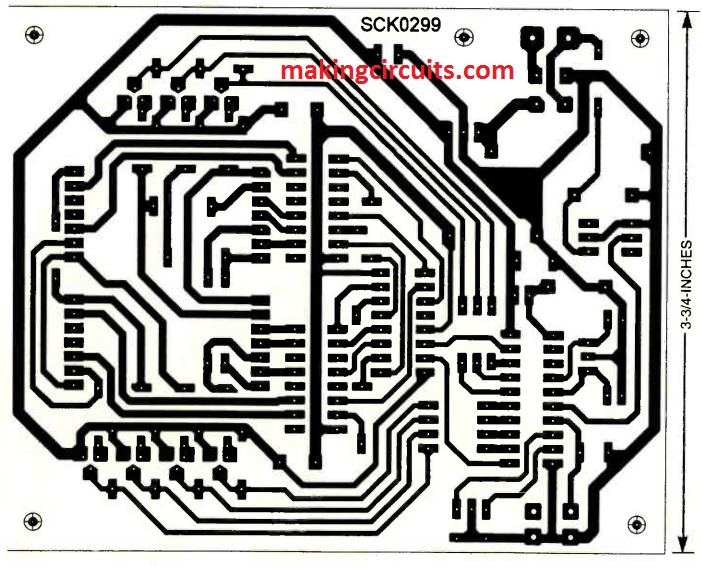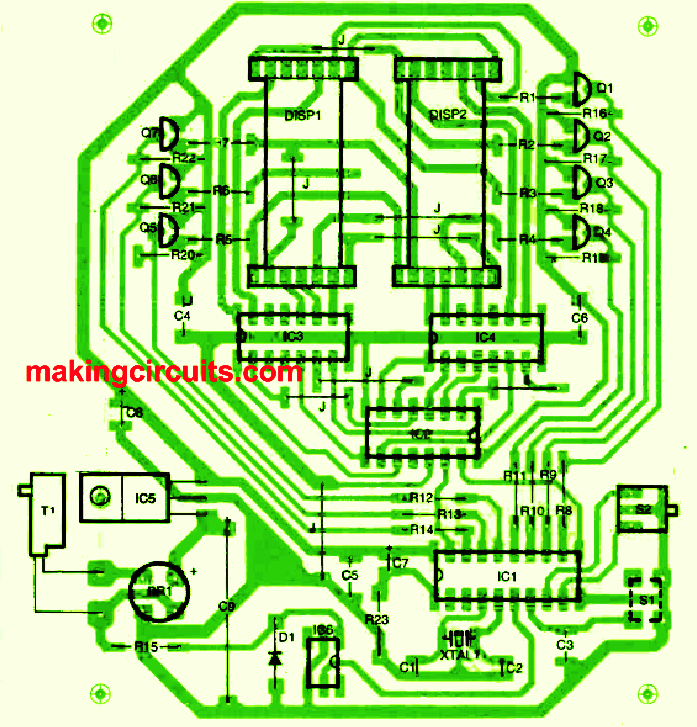The scrolling LED clock detailed in this post produces a great timepiece by showcasing the numbers in a dot-matrix arrangement and scrolling the digits in a ticker-tape manner. Using this method an attractive clock that is really special is presented. Put it on your table, mantle, or stand and enjoy the interest which it receives!
How it Works

Apparently from the circuit diagram shown in Fig. 1 above, the center of the Scrolling Clock is IC1, an AT89C2051 microcontroller manufactured by Atmel.
It is hard-wired to address many different features, such as screen multiplexing, keeping time, dot pattern encoding, scrolling, and time period adjustments. The AT89C2051 includes 2000 bytes of "flash" program memory, 128 bytes of RAM, 15 input-output lines, two 16 -bit timers, a serial interface circuit, an analog comparator, and an interrupt process that will deal with 5 diverse forms of interrupts.
It is completely interfaceable with Intel's MCS -51 series of microcontrollers with regards to both the layout architecture and instruction set.
Although the microcontroller is performing a lot of the function in the Scrolling Clock, a few extra circuitry is necessary. Let's get started with the power supply. The whole circuit obtains power through a 9 volt AC/DC adapter.
The rectified supply is filtered by capacitor C9, and stabilized to 5 volts by IC5. For accuracy and reliability, the frequency employed by IC1 for monitoring the time is extracted from the 60 Hz AC mains line.
The frequency of the utility AC mains line is stored to more restrictive tolerances than the finest crystal time base may anticipate to attain.
Construction
Since it's a microcontroller based venture, the Scrolling Clock has several interconnections across its parts and also high frequencies surrounding the display multiplexer and IC1's crystal.
Therefore , a PCB becomes a strict requiremenet. Thankfully, a single -sided board design is possible; through plated holes won't be an issue for individuals who want to etch their own personal PCB.

Get started by adding the various jumpers required to link up stages of the circuit with each other.
The parts must be mounted according to their height, from tiniest to biggest for simplicity of construction.
Whenever you can, mount the semiconductors very last; decreasing the hassles of their frequent handling and minimize static-electric damage concerns.
Remember that a number of parts have +/- polarity; check their direction carefully before soldering these into position.

How to Set Up
Set S2 to the middle or RUN position. As soon as power will be given to the Scrolling Clock, the internal time is reset to 12:00 and also the number 12 blinks on the screen.
When you find that down the road, you are going to realize that there is a power failure and the time has to be reset. To set the hours, transfer switch S2 to the HOURS location.
The existing hours digits will blink within the screen. Press and hold S1 to move forward the hours.
To set the minutes, shift switch S2 towards the MINUTES location and repeat exactly the same above method. When you finish, set S2 back to the RUN position.
The time will at this point scroll throughout the screen. The Scrolling Clock is a assured attention catcher, and is certain to be spotted by your entire buddies, family members, and fellow workers.
Parts List
SEMICONDUCTORS
IC1- AT89C2051 microcontroller, integrated circuit
IC2- CD4017 decade counter, integrated circuit
IC3, IC4- ULN2003 NPN Darlington driver array, integrated circuit
IC5- LM7805 5 -volt regulator, integrated circuit
IC6 -4N27 optoisolator, integrated circuit
Q1- Q7- 2N2907 PNP transistor DISPI, DISP2- LTP1157 5 X 7 LED matrix display
D1 -1N914 silicon diode
BR1 -Bridge rectifier, 1 -amp
RESISTORS
(All resistors are' /4 -watt, 5% units.)
RI-R7-100-ohm
R8 -R15 -1000 -ohm
R16- R23- 10,000 -ohm
CAPACITORS
C 1, C2- 22 -pF, ceramic -disc
C3- 0.001 -11F, ceramic -disc
C4-C6 0.1 -µF, ceramic -disc
C7- 10 -µF, 16 -WVDC, electrolytic
C8- 100 -µF, 16 -WVDC, electrolytic
C9- 470 -µF, 25 -WVDC, electrolytic
ADDITIONAL PARTS AND
MATERIALS
XTAL1- 11.0592 -MHz crystal SI- Single -pole, single- throw, momentary contact switch (Digi -key
P8012S -ND or similar) S2- Single -pole, three- position, center - off slide switch
T1 -9 -volt AC, 500 -mA wall transformer Sockets, hardware, wire, etc.
Leave a Reply